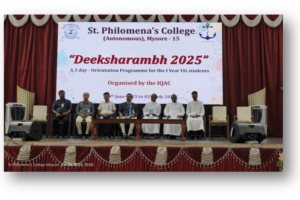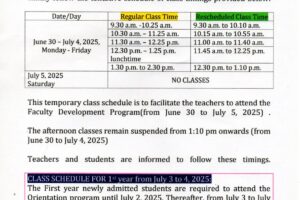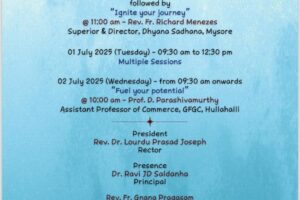
Visit to CSI Karunapura kannada Higher Primary School


Objective:
-
- To enable the children to name the four major blood types (phenotypes) in the ABO system.
- . To enable the children to name the two main “naturally occurring” antibodies to red cell antigens.
- To make provision for the prevention of adulteration of food
- To protect the Children from poisonous and harmful foods
- To prevent the sale of substandard foods
Outcome:
-
- Children learn about blood group A – has A antigens on the red blood cells with anti-B antibodies in the plasma.
- Children were educated about Some of the adulterants: are highly toxic for the body leading to heart failure, liver disorders, kidney disorders & many more
Subject: Biotechnology
Venue :CSI Karunapura kannada Higher Primary School
8MG6+3RM, St Mary’s Rd, N R Mohalla,
Rajendra Nagar, Mysuru, Karnataka 570007
Detailed report
The department of Biotechnology has organized an visit to the students of BtCZ, BtBMb 8.03.2022.The Faculty along with a team of students visited the school. The head misters of the school Mrs.Vimala A. Welcomed the students and the staff. The aim of the visit is to share the knowledge with blooming stars of the class 5th, 6th and 7th including the teachers. Students were divided into groups and each group was taken over by a team of students and staff. Children were practically demonstrated with Blood grouping and food adulterants.
Children learnt about blood grouping techniques and blood group A – has A antigens on the red blood cells with anti-B antibodies in the plasma. blood group B – has B antigens with anti-A antibodies in the plasma. blood group O – has no antigens, but both anti-A and anti-B antibodies in the plasma. blood group AB – has both A and B antigens, but no antibodies. Children even astonished to see the adulterants in their food products.

Children were educated about Some of the adulterants: are highly toxic for the body leading to heart failure, liver disorders, kidney disorders & many more.
Adulteration also affects the quality of the product leading hindrance to the nutritive value of the product thus leading to nutritive deficiency in our body Some of the adulterants that are used in milk are water, chalk, urea, caustic soda and skimmed milk, Tea leaves are usually adulterated with same coloured leaves, some might not even be edible. Several cases of liver infection across the country have been reported due to consuming adulterated tea, Different coloured and textured vegetables are often coloured with different dyes and substances. These vegetables are mostly adulterated with malachite green, a chemical dye which is known to have carcinogenic.
Common adulterants in fruits and vegetables are oxytocin , saccharin, wax, calcium carbide and copper sulphate. Students were educated about : silver becoming expensive many sweet shop owners use silver vark that could contain aluminium. The most common ingredients in making these sweets are khoya and chenna and they’re often adulterated with starch. The most commonly adulterated dal is arhar dal and is usually adulterated with metanil yellow. Soap stone or other earthy material and foreign resinare the common adulterant used in Asafoetida. Papaya seeds, black berries are the common adulterant used in black pepper as they are almost similar in size but tasteless (sometimes bitter). Red chilli powder is adulterated with brick powder, salt powder or talc powder and artificial colours like Sudan Red. Our students not only educated about food adulterants and grouping of blood they were even asked to demonstrate the same once they reach home to the parents. The teaching and non teaching staff of the school were also practically enriched with the knowledge. The HM offered refreshments to the staff and students. As a token of love our Students give them chocolates.
The visit of our department educated the staff and students practically food adulterants and blood grouping.

Organised by
Coordinator: Ms.Milagris Antonius
Convenor: Naziya Habeeb M.



